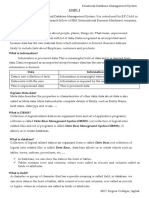100%(1)100% found this document useful (1 vote)
2K viewsGenerations of Programming Language
The document discusses the five generations of programming languages:
1) First generation languages are machine languages that program at the lowest level of abstraction.
2) Second generation languages use assembly languages with mnemonics instead of binary.
3) Third generation languages are high-level languages that allow programmers to focus on logic without considering computer architecture.
4) Fourth generation languages further increase productivity by reducing time and effort needed for application development.
5) Fifth generation languages focus on artificial intelligence and neural networks.
Uploaded by
MaPy TVCopyright
© © All Rights Reserved
Available Formats
Download as DOCX, PDF, TXT or read online on Scribd
100%(1)100% found this document useful (1 vote)
2K viewsGenerations of Programming Language
The document discusses the five generations of programming languages:
1) First generation languages are machine languages that program at the lowest level of abstraction.
2) Second generation languages use assembly languages with mnemonics instead of binary.
3) Third generation languages are high-level languages that allow programmers to focus on logic without considering computer architecture.
4) Fourth generation languages further increase productivity by reducing time and effort needed for application development.
5) Fifth generation languages focus on artificial intelligence and neural networks.
Uploaded by
MaPy TVCopyright
© © All Rights Reserved
Available Formats
Download as DOCX, PDF, TXT or read online on Scribd
You are on page 1/ 3
Generations of programming language
Programming languages have been developed over the year in a phased manner.
Each phase of developed has made the programming language more user-
friendly, easier to use and more powerful. Each phase of improved made in the
development of the programming languages can be referred to as a generation.
The programming language in terms of their performance reliability and
robustness can be grouped into five different generations,
1. First generation languages (1GL)
2. Second generation languages (2GL)
3. Third generation languages (3GL)
4. Fourth generation languages (4GL)
5. Fifth generation languages (5GL)
1. First Generation Language (Machine language)
The first generation programming language is also called low-level programming
language because they were used to program the computer system at a very low
level of abstraction. i.e. at the machine level. The machine language also referred
to as the native language of the computer system is the first generation
programming language. In the machine language, a programmer only deals with
a binary number.
Advantages of first generation language
They are translation free and can be directly executed by the computers.
The programs written in these languages are executed very speedily and
efficiently by the CPU of the computer system.
The programs written in these languages utilize the memory in an efficient
manner because it is possible to keep track of each bit of data.
2. Second Generation language (Assembly Language)
The second generation programming language also belongs to the category of
low-level- programming language. The second generation language comprises
assembly languages that use the concept of mnemonics for the writing program.
In the assembly language, symbolic names are used to represent the opcode and
the operand part of the instruction.
Advantages of second generation language
It is easy to develop understand and modify the program developed in
these languages are compared to those developed in the first generation
programming language.
The programs written in these languages are less prone to errors and
therefore can be maintained with a great case.
3. Third Generation languages (High-Level Languages)
The third generation programming languages were designed to overcome the
various limitations of the first and second generation programming languages.
The languages of the third and later generation are considered as a high-level
language because they enable the programmer to concentrate only on the logic
of the programs without considering the internal architecture of the computer
system.
Advantages of third generation programming language
It is easy to develop, learn and understand the program.
As the program written in these languages are less prone to errors they are
easy to maintain.
The program written in these languages can be developed in very less time
as compared to the first and second generation language.
Examples: FORTRAN, ALGOL, COBOL, C++, C
4. Fourth generation language (Very High-level
Languages)
The languages of this generation were considered as very high-level
programming languages required a lot of time and effort that affected the
productivity of a programmer. The fourth generation programming languages
were designed and developed to reduce the time, cost and effort needed to
develop different types of software applications.
Advantages of fourth generation languages
These programming languages allow the efficient use of data by
implementing the various database.
They require less time, cost and effort to develop different types of
software applications.
The program developed in these languages are highly portable as
compared to the programs developed in the languages of other
generation.
Examples: SOL, CSS, coldfusion
5. Fifth generation language (Artificial Intelligence
Language)
The programming languages of this generation mainly focus on constraint
programming. The major fields in which the fifth generation programming
language are employed are Artificial Intelligence and Artificial Neural Networks
Advantages of fifth generation languages
These languages can be used to query the database in a fast and efficient
manner.
In this generation of language, the user can communicate with the
computer system in a simple and an easy manner.
Examples: mercury, prolog, OPS5
You might also like
- Aspnet The Complete Reference by Matthew Macdonald Robert Standefer 0072195134 PDFNo ratings yetAspnet The Complete Reference by Matthew Macdonald Robert Standefer 0072195134 PDF5 pages
- Bradstreet Anne Upon The Burning of Our PDFNo ratings yetBradstreet Anne Upon The Burning of Our PDF4 pages
- BCA I Year Digital Computer Oragnisation Practice QuestionsNo ratings yetBCA I Year Digital Computer Oragnisation Practice Questions6 pages
- Language Translators Computer Science As LevelNo ratings yetLanguage Translators Computer Science As Level5 pages
- Unit 4 Application Development On Dot Net-1No ratings yetUnit 4 Application Development On Dot Net-161 pages
- Object Oriented Software Engineering Notes BCA Degree 1st YearNo ratings yetObject Oriented Software Engineering Notes BCA Degree 1st Year31 pages
- Introduction To Programming and Problem SolvingNo ratings yetIntroduction To Programming and Problem Solving33 pages
- Archival Principles Respect Des Fonds and Principe de Provenance100% (1)Archival Principles Respect Des Fonds and Principe de Provenance2 pages
- Unit 1 Introduction To System Software Short Answer QuestionsNo ratings yetUnit 1 Introduction To System Software Short Answer Questions23 pages
- Final Course Outline Programming Fundamentals0% (1)Final Course Outline Programming Fundamentals11 pages
- Question Bank 1. A and B Are Partners Sharing Profits in The Ratio of 3: 2 With Capitals of Rs. 50,000 and Rs. 30,000No ratings yetQuestion Bank 1. A and B Are Partners Sharing Profits in The Ratio of 3: 2 With Capitals of Rs. 50,000 and Rs. 30,0002 pages
- COSC1101 - Programming Fundamentals Lec1No ratings yetCOSC1101 - Programming Fundamentals Lec118 pages
- Computer - Science - Notes - CH04 - Pointers NotesNo ratings yetComputer - Science - Notes - CH04 - Pointers Notes10 pages
- Unit 4 C Programs: Trapezoidal Method Algorithm, Flowchart and Code in C100% (1)Unit 4 C Programs: Trapezoidal Method Algorithm, Flowchart and Code in C7 pages
- Exercises & LAB 1: Exercises - Silberschatz 9'th Edition, Operating Systems ConceptsNo ratings yetExercises & LAB 1: Exercises - Silberschatz 9'th Edition, Operating Systems Concepts5 pages
- Kasaai Chronicles Brutal Realities of Rural India OR A Gut Wrenching Tale of Dirty PoliticsNo ratings yetKasaai Chronicles Brutal Realities of Rural India OR A Gut Wrenching Tale of Dirty Politics2 pages
- Three Mel Gibson Flicks To Brush Up With Before Force of NatureNo ratings yetThree Mel Gibson Flicks To Brush Up With Before Force of Nature2 pages
- EXO's Chen Personally Announced His Upcoming Military Enlistment On October 26No ratings yetEXO's Chen Personally Announced His Upcoming Military Enlistment On October 262 pages
- DR Reddy's Is Planning To Conclude Phase 3 Trials of COVID-19 Vaccine Sputnik V by The End of MarchNo ratings yetDR Reddy's Is Planning To Conclude Phase 3 Trials of COVID-19 Vaccine Sputnik V by The End of March1 page
- SSC CHSL Model Paper 2 WWW - Questionpaperz.inNo ratings yetSSC CHSL Model Paper 2 WWW - Questionpaperz.in17 pages
- Activity 1: Emotional Expression Non-Verbal100% (5)Activity 1: Emotional Expression Non-Verbal11 pages
- Language Focus and Vocabulary - Unit 2: Adverbs of Frequency Present Simple: Affirmative and NegativeNo ratings yetLanguage Focus and Vocabulary - Unit 2: Adverbs of Frequency Present Simple: Affirmative and Negative1 page
- Latihan soal Passive Voice kls 9 _ QuizizzNo ratings yetLatihan soal Passive Voice kls 9 _ Quizizz5 pages
- Teaching English Pronunciation for a Globa - Robin Walker_Gemma ArcherNo ratings yetTeaching English Pronunciation for a Globa - Robin Walker_Gemma Archer157 pages
- Kids Can Be Big Helpers: Pages 426 427 Pages 428 431No ratings yetKids Can Be Big Helpers: Pages 426 427 Pages 428 4316 pages
- AI Planning Applications and Execution 16x9 v4No ratings yetAI Planning Applications and Execution 16x9 v442 pages
- Racot: Actor H 2. Breduil: 3. Mrefra: 4.himaecnc: 5. Catnotacun: 6.TARIST: 7. Rodtoc: 8. NengreieNo ratings yetRacot: Actor H 2. Breduil: 3. Mrefra: 4.himaecnc: 5. Catnotacun: 6.TARIST: 7. Rodtoc: 8. Nengreie4 pages



































































































